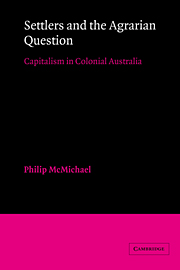Book contents
- Frontmatter
- Contents
- List of tables
- Preface
- 1 The social structure of British hegemony
- PART I THE COLONIAL ECONOMY ENTERS THE WORLD MARKET (1788–1830)
- PART II THE SQUATTING PHASE OF PASTORALISM (1830s AND 1840s)
- 4 Squatting and colonial politics
- 5 Merchants and growers
- 6 Pastoral enterprise in the colonial economy
- 7 The conservative character of pastoralism
- PART III CONFRONTING THE AGRARIAN QUESTION (1840–1900)
- APPENDIXES
- References
- Index
6 - Pastoral enterprise in the colonial economy
Published online by Cambridge University Press: 18 December 2009
- Frontmatter
- Contents
- List of tables
- Preface
- 1 The social structure of British hegemony
- PART I THE COLONIAL ECONOMY ENTERS THE WORLD MARKET (1788–1830)
- PART II THE SQUATTING PHASE OF PASTORALISM (1830s AND 1840s)
- 4 Squatting and colonial politics
- 5 Merchants and growers
- 6 Pastoral enterprise in the colonial economy
- 7 The conservative character of pastoralism
- PART III CONFRONTING THE AGRARIAN QUESTION (1840–1900)
- APPENDIXES
- References
- Index
Summary
INTRODUCTION
Colonial wool growing developed within the expanding British mercantile system. Indeed, as a makeshift form of land use, squatting accommodated well the liberal supply of commercial credit from London. From this perspective, wool growing simply enhanced financial and commercial fortunes. In world-economic terms, such temporary occupation of the imperial land frontier represented a large-scale “putting-out” system, organized around the wool trade by an international merchant banking community.
This mercantile putting-out relationship appeared within the colonial society as the squatting system advanced beyond the settled regions. The latter was a source of fine-wooled flocks and commercial credit in particular. To be sure, the origins of credit were ultimately metropolitan, but a local commercial apparatus of merchants and factors in port cities organized the financial and trading sphere. The social geography of the colony in this period thus conformed to the enclave-like relationships of the squatting system; market relations were largely confined to the coastal towns, which serviced a specialized rural hinterland.
The object of this chapter is to examine the relationship between the character of wool production in this period and the social division of labor in the colony.
THE SQUATTING “SWARM”
The squatting phase of colonial wool growing began in 1829 as flockowners breached the boundaries of the official “Nineteen Counties” to create a new land frontier called the “unsettled districts.” The squatting expansion resembled patterns begun during the 1820s when, to gain access to cheap, fresh pastures, graziers obtained a limited tenure (“ticket of occupation”) by paying a minimal rent for the right to graze their flocks on Crown land over which they had no legal rights.
- Type
- Chapter
- Information
- Settlers and the Agrarian QuestionCapitalism in Colonial Australia, pp. 119 - 144Publisher: Cambridge University PressPrint publication year: 1984



